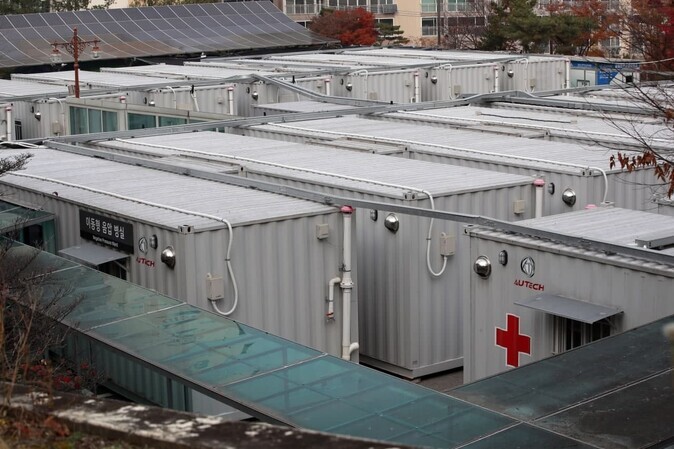hankyoreh
Links to other country sites 다른 나라 사이트 링크
New measures aim to increase bed turnover rate in COVID-19 critical care units

The South Korean government plans to respond to a dire shortage of COVID-19 hospital beds in the greater Seoul area by more accurately determining the severity of symptoms for COVID-19 patients currently being treated in dedicated beds and quickly transferring recovered patients to lower-level beds, while relocating other patients to hospitals outside of the capital region.
These measures are part of a plan for ensuring sickbed availability announced in a regular briefing Friday morning by Minister of Health and Welfare Kwon Deok-chul, who serves as first deputy director of the Central Disaster and Safety Countermeasures Headquarters (CDSCH).
“With the cooperation of the National Medical Center and Korean Society of Critical Care Medicine, we will be stepping up [sickbed] allocation and assessment to ensure that hospitalizations center on the patients who truly need critical care treatment,” he said.
“In cases where [COVID-19] patients refuse to be transferred or discharged despite not requiring critical care hospitalization because their treatment has been completed or they have mild symptoms, we will be applying a principle of [patients bearing] responsibility for [hospitalization] costs,” he added.
Ahead of the briefing, Kwon delivered a report on measures for beefing up the capital region’s COVID-19 care response while attending a meeting with the heads of 22 greater Seoul-area tertiary hospitals presided over by Kim Boo-kyum, Korea’s prime minister and chief of the CDSCH.
The new measures reflect the currently saturated state of critical care beds in greater Seoul, with 28% of beds occupied by patients who could potentially be transferred elsewhere for treatment.
Disease control authorities have been adjusting their measures amid a sharp rise in confirmed cases — including ones considered severe or critical — since the relaxation of restrictions as part of a “gradual return to everyday life.”
A total of 3,034 new confirmed cases were counted as of the end of the day Thursday. The number was down by 258 from 3,292 the day before, but the 499 patients classified as having severe or critical systems was just below the 500-patient threshold announced by the government as a level it could “stably manage.”
As of 5 pm on Thursday, the occupancy rate for dedicated critical care beds in greater Seoul was 78.2% (537 out of 687 available), which exceeded the 75% threshold for considering the development of an “emergency plan.”
Measures are being focused on incentivizing hospitals to actively cooperate with ensuring critical care bed availability. Lee Ki-il, a senior official at the CDSCH, explained that the plans included “covering all request and transport costs for when severe COVID-19 patients are relocated to other hospitals after their condition improves” and “encouraging medical institutions to take part [in sickbed efficiency improvements] by providing some hospitalization cost incentives to hospitals that accept relocated patients.”
He also said, “Patients with moderate symptoms are currently being hospitalized for 10 days on average, and we also plan to consider a system where if a patient’s condition improves after five days, we would provide [hospitals] a portion of hospitalization costs for the remaining five days [even if the patient is discharged].”
By Lee Jae-ho, staff reporter
Please direct questions or comments to [english@hani.co.kr]

Editorial・opinion
![[Column] The state is back — but is it in business? [Column] The state is back — but is it in business?](https://flexible.img.hani.co.kr/flexible/normal/500/300/imgdb/original/2024/0506/8217149564092725.jpg) [Column] The state is back — but is it in business?
[Column] The state is back — but is it in business?![[Column] Life on our Trisolaris [Column] Life on our Trisolaris](https://flexible.img.hani.co.kr/flexible/normal/500/300/imgdb/original/2024/0505/4817148682278544.jpg) [Column] Life on our Trisolaris
[Column] Life on our Trisolaris- [Editorial] Penalties for airing allegations against Korea’s first lady endanger free press
- [Editorial] Yoon must halt procurement of SM-3 interceptor missiles
- [Guest essay] Maybe Korea’s rapid population decline is an opportunity, not a crisis
- [Column] Can Yoon steer diplomacy with Russia, China back on track?
- [Column] Season 2 of special prosecutor probe may be coming to Korea soon
- [Column] Park Geun-hye déjà vu in Yoon Suk-yeol
- [Editorial] New weight of N. Korea’s nuclear threats makes dialogue all the more urgent
- [Guest essay] The real reason Korea’s new right wants to dub Rhee a founding father
Most viewed articles
- 1[Column] Why Korea’s hard right is fated to lose
- 2Amid US-China clash, Korea must remember its failures in the 19th century, advises scholar
- 360% of young Koreans see no need to have kids after marriage
- 4[Column] The state is back — but is it in business?
- 5Presidential office warns of veto in response to opposition passing special counsel probe act
- 6[Editorial] Stagnant youth employment poses serious issues for Korea’s future
- 7Inside the law for a special counsel probe over a Korean Marine’s death
- 8[Column] Can Yoon steer diplomacy with Russia, China back on track?
- 9[Guest essay] Maybe Korea’s rapid population decline is an opportunity, not a crisis
- 10[Editorial] Penalties for airing allegations against Korea’s first lady endanger free press